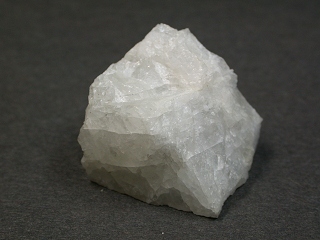
Elizabeth A. Johnson and George R. Rossman
Division of Geological and Planetary Sciences,
MS 170-25
California Institute of Technology, Pasadena, CA 91125-2500

Colorless ussingite from Taser Slope,
Illimaussaq Complex,
SW Greenland
The mineral ussingite, Na2AlSi3O8(OH), an “interrupted” tectosilicate, has strong hydrogen bonding between OH and the other non-bridging oxygen in the structure. Infrared spectra contain a strongly polarized, very broad OH stretching band with an ill-defined maximum between 1500-1800 cm-1, and a possible OH librational bend at 1295 cm-1. The IR spectra confirm the orientation of the OH vector within the triclinic unit cell as determined from X-ray refinement (Rossi et al. 1974). There are three distinct bands in the 1H NMR spectrum of ussingite: a predominant band at 13.5 ppm (TMS) representing 90% of the structural hydrogen, a second band at 15.9 ppm corresponding to 8% of the protons, and a third band at 11.0 ppm accounting for the remaining 2% of structural hydrogen. From the correlation between hydrogen bond length and 1H NMR chemical shift (Sternberg and Brunner 1994), the predominant hydrogen bond length was calculated to be 1.49 Å, in comparison to the hydrogen bond length determined from X-ray refinement (1.54 Å). The population of protons at 15.9 ppm is consistent with 5-8% Al-Si disorder. Although the ussingite crystal structure and composition are similar to those of low albite, the bonding environment of OH in low albite and other feldspars, as characterized through IR and 1H NMR, is fundamentally different from the strong hydrogen bonding found in ussingite.

Lavender ussingite from the Illimaussaq Complex, Greenland